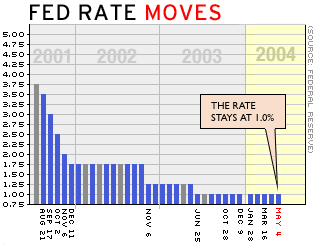NEW YORK (CNN/Money) - In case there was any doubt, Friday's jobs report made a Fed rate hike a done deal. The only questions now are: how far and how fast will rates rise?
The answer depends on whether or not policy-makers have been watching the right numbers.
The Labor Department's report Friday of a second consecutive blowout number for monthly job growth sent economists scrambling to readjust their forecasts for the Federal Reserve's first interest-rate hike since May 2000.

"Up until now, we viewed the probability of a Fed tightening starting in 2005 as more likely than a start in 2004," Credit Suisse First Boston economists wrote in a note to clients after the jobs report. "The data changed that risk profile. We now expect Fed tightening to commence no later than the [Fed's] August [policy] meeting."
Traders at the Chicago Board of Trade thought the Fed would be less patient than that. The implied yield on the July fed funds futures contract showed traders were betting on a 90 percent chance that policy-makers would raise rates by a quarter point at their next meeting, scheduled for June 29-30.
Central bankers slashed the fed funds rate, an overnight bank lending rate used to change the economy's velocity, 13 times between 2001 and 2003, one of its most aggressive campaigns in history. Earlier this week, amid signs of higher consumer prices and a healing job market, the Fed said the risk of falling prices had disappeared and warned it might soon start to raise short-term rates to head off inflation.
Some analysts worry that the current fed funds rate of 1 percent, the lowest since the Kennedy administration, is unsustainably low and that it has already fueled a tsunami of higher prices that will slam the economy and force the Fed to raise rates abruptly to keep inflation from spinning out of control.
In fact, many bond traders seem to feel that way.
The December fed funds futures contract says traders expect the fed funds rate to rise by a full percentage point by the end of the year. There are just five Fed meetings the rest of the year, so traders expect policy-makers to hike rates by a quarter point in four out of those five meetings.
And if recent history is any guide, the market might not be pricing in enough rate hikes. In the Fed's latest tightening campaign, beginning in 1994, it raised rates 7 times in 12 months, and picked up steam as it rolled along -- the last four hikes of that campaign were half a point or more.
"If anything, we could get an additional 175 basis points this year, potentially, if the economy continues to show the kind of vigor we've had so far," said Anthony Crescenzi, bond strategist at Miller Tabak & Co. There are 100 basis points in one percent.
| Related stories
|

|
|
|
|
Some Fed policy-makers would probably disagree. They point to the "slack" still in the economy, in the form of unemployed workers and idle factory equipment, and say it will need to be pulled tight before inflation becomes a big headache.
Labor costs are the biggest component of inflation, and strong productivity -- output per worker hour -- will keep those costs low, keeping inflation in check, some Fed policy-makers and other economists believe. If they're right, they will have plenty of room to take their sweet time raising rates.
"For the Fed, productivity is the antidote to inflation, and that's still very strong," said former Fed economist Lara Rhame, now senior economist at Brown Brothers Harriman. "It's inconceivable that the Fed would tighten in four out of its next five meetings."
The November presidential election could be a big speed bump keeping the Fed from acting too aggressively this year.
Fed Chairman Alan Greenspan has taken some of the blame -- fairly or unfairly -- for then-President Bush's loss in 1992, and the current President Bush probably doesn't want an aggressive rate-tightening campaign in the middle of his re-election campaign.
"By the time the election is over, the Fed might be in a position to increase rates more aggressively," said Sung Won Sohn, chief economist at Wells Fargo. "In 2005, we might see rates going up more than a quarter (percentage point) every other month."

|

